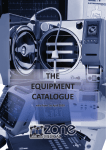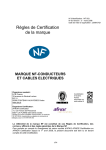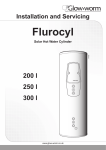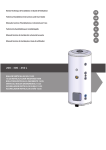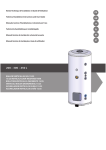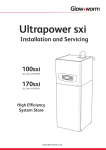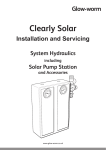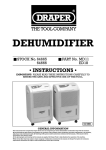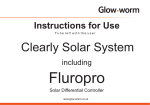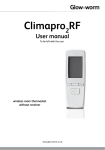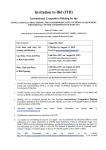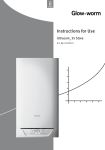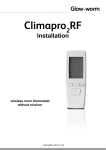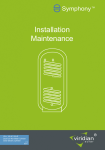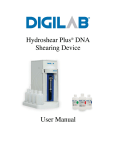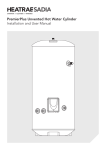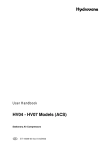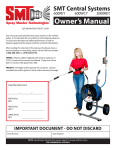Download Flurocyl Instructions for use Installation and Servicing - Glow-worm
Transcript
Instructions for use Installation and Servicing Solar Hot Water Cylinders/ Flurocyl2 200 250 300 Table of contents INT R O D U C T I O N 1 Instructions guidance.................................................................................................................... 3 1.1 1.2 1.3 1.4 1.5 2 Safety instructions and regulations................................................................................................ 3 2.1 2.2 2.3 2.4 2.5 3 Product documentation........................................................................................3 Associated documents ........................................................................................3 Storage of documents..........................................................................................3 Explanation of symbols........................................................................................3 Benchmark..........................................................................................................3 Intended use.......................................................................................................3 General safety information . .................................................................................4 Cylinder safety information...................................................................................4 Cylinder identification plate..................................................................................4 Regulation and statutory requirements..................................................................4 Introducing your appliance............................................................................................................ 5 3.1 Appliance description..........................................................................................5 r e ad c are f ul ly b e for e u sin g 4 Operation..................................................................................................................................... 6 4.1 4.2 4.3 4.4 4.5 5 Adjusting the hot water temperature.....................................................................6 Switching off hot water.........................................................................................6 Frost protection...................................................................................................6 Cleaning the cylinder...........................................................................................6 Fault finding........................................................................................................7 Inspection and Maintenance.......................................................................................................... 7 TECH N I CAL DATA 6 Technical data............................................................................................................................... 8 INSTALLAT I O N 7 Hydraulic and electrical schematics.............................................................................................. 10 8 Description of the components .................................................................................................... 12 8.1 8.2 9 Cylinder installation.................................................................................................................... 13 9.1 9.2 9.3 9.4 9.5 9.6 9.7 10 Flurocyl2 solar cylinder.......................................................................................12 Solar pump safety thermostat.............................................................................12 Cylinder device description.................................................................................13 Installation site..................................................................................................15 Installing of discharge pipe................................................................................15 Pipes for the reheating circuit.............................................................................17 Installing hot water pipes...................................................................................18 Installation of cold water pipe.............................................................................18 Electrical installation..........................................................................................20 Commissioning .......................................................................................................................... 21 10.1 Filling the cylinder.............................................................................................21 -1- Table of contents MA I N TE N AN CE 11 Inspection and maintenance........................................................................................................ 23 11.1 Maintenance checklist........................................................................................23 11.2 Draining the cylinder..........................................................................................23 11.3 Fault diagnosis..................................................................................................24 12 Recycling and disposal................................................................................................................ 25 12.1 Cylinder disposal...............................................................................................25 12.2 Disposal of packaging........................................................................................25 13 Customer service and manufacturer's warranty............................................................................. 26 13.1 Glow-worm service.............................................................................................26 13.2 Glow-worm warranty..........................................................................................26 14 -2- Spare parts................................................................................................................................. 27 INTRODUCTION INTRODUCTION 1 Instructions guidance 1.1 Product documentation The instructions are an integral part of the appliance and must be handed to the user on completion of the installation in order to comply with the current regulation. • Carefully read the manual, to understand all the information to enable safe installation, use and servicing. No liability can be accepted in the event of damage for not complying with the guidance in this instruction manual. 1.2 Associated documents When installing and maintaining the solar system, you must observe all of the installation and maintenance instructions for system parts and components as well as those for other accessories which are used in the system. These installation and maintenance manuals are provided with the relevant system parts, components, and accessories. 1.3 Storage of documents Pass this installation manual and all other applicable documents and, if necessary, any required aids to the system operator. The system operator will be responsible for storing them so that the instructions and aids are available when required. 1.4 Explanation of symbols installed, commissioned and serviced in accordance with the manufacturer’s instructions by competent persons and that it meets the requirements of the appropriate Building Regulations. The Benchmark Checklist must be used to demonstrate compliance with Building Regulations and must be provided to the customer for future reference. Installers are required to carry out installation, commissioning and servicing work in accordance with the Benchmark Code of Practice which is available from the Heating and Hotwater Industry Council who manage and promote the Scheme. • Visit www.central heating.co.uk for more information. 2 2.1 Safety instructions and regulations Intended use Glow-worm cylinders are constructed using state-of-the-art technology in accordance with recognised safety regulations. Nevertheless, there is still a risk of injury or death to the user or others or of damage to the unit and other property in the event of improper use or use for which the unit is not intended. Glow-worm cylinders are not intended for use by persons who have inadequate experience and/or knowledge, unless they are supervised by a person responsible for their safety or have been given instructions by this person regarding the operation of the unit. Children must be supervised to ensure that they do not play with the unit. Glow-worm Flurocyl2 domestic hot water cylinders are unvented, indirectly heated domestic hot water cylinders designed for use with gas-fired boilers as per GB standards for hot water supply systems. The cylinders work with the pressure of the water supply line and do not need a cold water tank for their supply. a DANGER: Risk of injuries. They are used only to supply potable water heated up to 80°C in solar systems with a collector array. They may only be used for this purpose. The cylinders can be used in combination with a downstream gas-fired boiler for hot water generation in accordance with GB standards. e DANGER: Risk of electric shock. Any other use or extended use is considered to be improper. Improper use of any kind is prohibited. ATTENTION: Risk of damage to the appliance or to its vicinity. IMPORTANT: Useful information. 1.5 Benchmark The manufacturer/supplier is not liable for any damage resulting from improper use. The user alone bears the risk. Intended use also includes observing the operating and installation manuals and all other applicable documents, as well as complying with the inspection and maintenance conditions. At the end of this manual there is a commissioning report which you must fill in and hand over to the operator. All installers should have a current ID card and registration number. The cylinder must be installed by a competent person approved at the time by the Health and safety Executive to the prevailing standards, installation book and building regulations at the time of installation. Benchmark places responsibilities on both manufacturers and installers. The purpose is to ensure that customers are provided with the correct equipment for their needs, that it is 0020115479_03 - 10/12 - Glow-worm -3- INTRODUCTION 2.2 General safety information 2.3.3 Avoiding damage caused by leaks Installation and adjustment as well as service, maintenance and repair must be carried out by a competent person approved at the time by the Health and Safety Executive and be in accordance with the relevant requirements of the Local Authority, Building Regulations, Building Regulations (Scotland), Building Regulations (Northern Ireland), and the bye-laws of the local Water Undertaking. If there are leaks in the pipe network, close off the cold water stop valve on the safety assembly and notify an engineer qualified to work on unvented systems to rectify the leaks. 2.3 If the system is in stagnation then hot steam can discharge from the expansion relief valve of the solar pump unit. This may be visible in the receptor canister. Should this occur contact your installer for advice. Cylinder safety information This product has been assessed and found to comply with the requirements of the Building Regulations for unvented hot water storage systems and must not be altered or modified in any way. In the event of parts replacement, use only genuine spare parts supplied by Glow-worm. The installation is subject to Building Regulation approval. Notify the Local Authority of intention to install. As stipulated in the manual "Handling Operations Regulations 1992", the weight of the unit exceeds that which should be lifted by one person. Without potential equalisation, life-threatening voltage from the electric immersion heater can reach the piping and water taps.Earth the electric immersion heater. If the solar cylinder is connected with pipes made of non-metallic materials and is not earthed, corrosion damage can occur. 2.3.4 Avoiding burns and scalds For scald protection, install a hot water thermostat mixer in the system. The temperature of the stored water could reach high temperatures after solar charging and your Glow-worm solar installer will have fitted a tempering valve so as to prevent this reaching the hot water taps. Should excessively hot water reach your hot taps contact your installer immediately. 2.3.5 Preventing damage due to unauthorised changes to the unit Changes to the supply lines, relief valve termination, and expansion relief valve may only be carried out by an engineer qualified to work on unvented systems. Never shut off the expansion relief valve or relief valve termination. Earth the solar cylinder for potential equalisation and to protect against overvoltage. If using non-metallic pipes on the water route, make sure that they are designed by the manufacturer for continuous operation at 70°C and operation by the hour at temperatures of up to 95°C Always use a suitable open-end spanner to tighten or undo threaded connections. Do not use pipe wrenches, extensions, etc. If the water does not meet the requirements of the UK water quality standards with a maximum chloride level of 250 mg/l, corrosion damage may occur to the cylinder. Only use the cylinder to heat potable water. 2.3.1 Electric potential equalisation If you use an electric immersion heater in the cylinder, the external voltage may build up electrical potential in the water which can result in the electrochemical corrosion of the electric immersion heater. Make sure that both the hot water and cold water pipes are connected to the earth line by means of earth cable directly on the cylinder. You must also make sure that the electric immersion heater is connected to the earth line via the earthing terminal. 2.3.2 Preventing frost damage You should not turn the gas-fired boiler off completely so that you can still use all of the safety functions for your heating installation. If you want to take the unit out of operation for a relatively long period of time in an unheated room at risk from frost, you must completely drain the Flurocyl2. -4- Never bypass any of the security devices. 2.4 Cylinder identification plate The identification plate is attached to the middle of the cylinder at the factory. 2.5 2.5.1 Regulation and statutory requirements Cylinder and cylinder assembly Pressure equipment directive 97/23/EC Directive of the European Parliament and Council from 29th May, 1997 for the approximation of the laws on pressure equipment of the Member States EN 12977-3 Thermal solar systems and components; Custom built systems, Part 3: Performance characterisation of domestic hot water cylinders EN 12897:2006 Water supply - specification for indirectly heated unvented (closed) domestic hot water cylinders 0020115479_03 - 10/12 - Glow-worm INTRODUCTION EN 806-1 3.1.2 Specifications for installations inside buildings conveying water for human consumption - Part 1: General You can set the hot water temperature and reheating times in the upper half of the cylinder on the controller. EN 1717 One of the following controllers may be used depending on the design of your system: Protection against pollution of potable water installations and general requirements of devices to prevent pollution by backflow Hot water temperature regulation -- Glow-worm Fluropro EN 60335-2-21 -- Climapro2 in conjunction with a timer Safety of household and similar electrical appliances; Part 2: Particular requirements for storage water heaters (domestic hot water cylinders and hot water boilers) (IEC 335-2-21: 1989 and supplements 1; 1990 and 2; 1990, modified) Refer to the operating manual for the installed controller or timer. 2.5.2 CE Mark CE labelling shows that the appliance according to the model overview comply with the basic requirements of the applicable directives. The CE declarations of conformity can be viewed at the manufacturer's premises and can be supplied if necessary. 3.1.3 Electric immersion heater The cylinder is equipped with an additional electric immersion heater (3) with a heating output of 3 kW. The electric immersion heater is designed for use in unvented cylinders and has a thermostat with a temperature controller (2) and a safety thermostat (TCO) with a reset button (1). 3.1.4 Functional elements of cylinder 1 3 Introducing your appliance 2 3 3.1 Appliance description The Flurocyl2 solar cylinder is available in three sizes: 200, 250 and 300 litres. The containers are made from stainless steel with EPS with additional infared absorbing insulation. The cylinder works with the pressure of the water supply line and does not need a cold water tank for its supply. To enable the cylinder to work as well as possible, a cold water supply with an appropriate pressure and flow rate is required. 3.1.1 4 Safety devices The solar cylinder has been provided with all safety and control devices for operation of the unvented domestic hot water supply: -- Temperature/pressure relief valve (90 °C, 7 bar) -- Pressure limiting valve (3.5 bar) with line strainer Key 1 Reset button for reheating circuit 2 Cylinder thermostat 3 Electric immersion heater 4 Reset button for solar circuit -- Expansion relief valve (one-way valve, 6.0 bar) -- Solar pump safety thermostat, set to 80 °C, connected with the solar pump in order to isolate this heat source if there is a malfunction in the solar control. -- Safety thermostat for electric immersion heater (85 °C). -- Solar cylinder safety thermostat, set to 80 °C, to be connected to the 2-port motorised valve in order to isolate the primary heat source if a domestic water supply thermostat malfunction occurs. 0020115479_03 - 10/12 - Glow-worm -5- read carefully before using 4 Operation a a Always make sure that there is clear access to the cylinder to enable the use of the hot water thermostat controller and the thermostat mixer. Risk of scalding and bursts due to inappropriate alterations! There is a risk of escaping steam, bursting, and damage to the system if you make any changes to the cylinder, control system, supply lines for water and power (if present), relief valve termination, or expansion relief valve for the cylinder water. 4.2 Do not make any improper changes. 4.3 • Switch off the immersion heater and the gas-fired boiler (see the operating manual for the gas-fired boiler) to temporarily switch off the heating and hot water system. Frost protection Risk of scalding! Risk of damage due to frost! The output temperature of the draw-off points can reach 85 °C if the mixing valve is set incorrectly. If the cylinder is placed out of operation for a relatively long period of time in an unheated room (e.g. during a winter holiday), the cylinder must be completely drained. - Do not adjust the mixing valve. - If the output temperature at a draw-off point is too high or low, Contact an engineer qualified to work on unvented systems to adjust the temperature. 4.1 Switching off hot water Adjusting the hot water temperature The hot water temperature is set to the required value by the engineer qualified to work on unvented systems during the cylinder commissioning. If an external controller is installed for hot water temperature control, you can adjust the hot water temperature and reheating times using this controller. For information on making settings, see the operating manual for the controller. If no controller for hot water temperature control is installed, you can set the required hot water temperature on the cylinder thermostat (2). You can set the reheating times on the installed hot water timer. Refer to the operating manual for the hot water timer. - Contact an engineer qualified to work on unvented systems to drain the cylinder. If you are absent during a relatively long period when there is a risk of frost, make sure that you leave the central heating on and that the temperature in the cylinder room and in all other rooms are kept above freezing. 4.4 Cleaning the cylinder • Clean the outside of the cylinder only with a damp cloth, using soapy water if it is especially dirty. Do not use abrasive cleaning agents or solvents (any type of scouring agent, petroleum etc.) since they can damage the cladding and the cylinder fixtures. • Set the desired cylinder hot water temperature on the cylinder thermostat (2). • For optimum efficiency, choose a setting of 45 °C. • Use the operating manual for the gas-fired boiler to make sure that the unit is ready for operation. We recommend the cylinder is set to 60 °C periodically, to provide protection against the proliferation of harmful bacteria. If you are heating up water for the first time or after a long switch-off period, the full cylinder performance is only available following a waiting period. If the Flurocyl2 is installed in a cupboard, make sure that clothing and other objects are not placed on the cylinder, control devices, pipes, or other system components. -6- 0020115479_03 - 10/12 - Glow-worm read carefully before using 4.5 Fault finding Fault Remedy Fluid is dripping from the system? If possible, collect the fluid in a bucket and contact an engineer qualified to work on unvented systems. The controller issues a message telling me the sensor is faulty or there is a cable break? Contact an engineer qualified to work on unvented systems. The cylinder is not providing sufficient hot water? Check that the hot water temperature is set correctly on the controller (recommended value of approx. 45 °C, however, set periodically to 60 °C to provide protection against the proliferation of harmful bacteria) and that the gas-fired boiler is working. If the settings are correct, the cylinder may be calcified. Then: contact an engineer qualified to work on unvented systems. A safety thermostat trips? Contact an engineer qualified to work on unvented systems. Water escapes from the expansion relief valve? Contact an engineer qualified to work on unvented systems. 5 Inspection and maintenance An annual inspection/maintenance run by an engineer qualified to work on unvented systems is a prerequisite for ensuring that the cylinder is permanently ready for operation, reliable, and has a long service life. It is important that your hot water cylinder is serviced annually. We recommend entering into a maintenance agreement. After servicing, the servicing engineer must complete the relevant Service Interval Record section of the Benchmark Checklist located on the inside back pages of this document. e Risk of death from electric shock. Improperly executed work on the cylinder can result in a risk to life and limb. - Never try to rectify cylinder malfunctions yourself. - Contact an engineer qualified to work on unvented systems to rectify all malfunctions. a Risk of injury resulting from improper maintenance or repair. Failure to arrange for the system to be maintained and repaired and improper maintenance and repair can impair the operational safety of the unit, leading to injuries and damage to property - Never attempt to perform maintenance work or repairs on the cylinder yourself. - Always employ an engineer qualified to work on unvented systems. 0020115479_03 - 10/12 - Glow-worm -7- technical data TECHNICAL DATA 6 Technical data Unit Flurocyl2 200 Flurocyl2 250 Flurocyl2 300 Total capacity l 200 250 300 Actual capacity l 209.4 254.4 297.2 Hot water capacity (upper coil) l 104.8 142 144.2 Hot water capacity (solar coil) l 203.3 246.1 271.1 Dedicated solar volume l 104.6 112.4 153.0 Maximum supply pressure to pressure reducing valve bar 12 Maximum operating pressure of cylinder bar 7 Maximum operating pressure of heating coil bar 3.5 Maximum operating pressure of solar coil bar 6 Operating pressure bar 3.5 Pressure limiting valve bar 3.5 Expansion relief valve bar 6.0 Temperature and pressure relief valve bar 7.0 Charge pressure of hot water expansion vessel bar 4.0 Maximum temperature of heating circuit oC 85 Maximum temperature of potable hot water oC 85 Maximum temperature of solar fluid oC 85 Standing heat loss kW/24h 2.05 2.20 2.40 Heat up time according to EN 12897 mins 22 29 30 Recovery time (70% capacity) mins 16 21 22 Primary heat exchanger performance kW 14.9 15.3 15.0 Flow rate for primary heat exchanger performance l/min 23.3 23.3 23.3 Primary heat exchanger pressure drop mbar 79 78 79 Primary heat exchanger volume l 2.37 2.37 2.37 Primary heat exchanger surface area m2 0.5 0.5 0.5 Solar heat exchanger performance kW 18.7 18.5 16.5 Flow rate for solar heat exchanger performance l/min 23.3 23.3 23.3 Solar heat exchanger pressure drop mbar 97 95 98 Solar heat exchanger volume l 2.94 2.94 2.94 Solar heat exchanger surface area m2 0.62 0.62 0.62 Heat up time according to EN12897 (solar) mins 34 42 51 Temperature and pressure relief valve oC/bar 90 / 7.0 Dimensions Height mm 1593 1843 2153 Height with hot water draw off mm 1625 1875 2185 Topple measure mm 1680 1918 2217 Diameter mm 554.5 Depth mm 624 Net weight kg 40 43 50 Weight (filled) kg 249 298 347 Connections Cold water inlet 22mm compression joint Hot water draw-off 22mm compression joint Balanced pressure cold water outlet 22mm compression joint Secondary return 15 mm compression joint -8- 0020115479_03 - 10/12 - Glow-worm technical data Unit Flurocyl2 200 Flurocyl2 250 Flurocyl2 300 Primary heater flow 22mm compression joint Primar heater return 22mm compression joint Solar flow 22mm compression joint Solar return 22mm compression joint Primary heating circuit immersion sleeve size mm 8 Solar circuit immersion sleeve size mm 8 Electrical data Immersion heater (according to ENBS 60335) Length of immersion heater 2.7 kW / 230 V / 50 Hz inch 14 Two port motorised valve 230/240 V, 50 Hz Thermal cut out solar 230/240 V, 50 Hz Cylinder thermostat 230/240 V, 50 Hz Material data Cylinder body material Stainless Steel (1.4521) Cylinder jacket material Polypropylene Insulation material EPS with infrared absorber Insulation thickness 50 Corrosion protection Blowing agent for insulation material ODP Stainless Steel Pentane (GWP < 5) 0 The heat up time is based on a flow rate of 1400 l/h at 80 °C. Temperature rise from 15 °C to 60 °C. 0020115479_03 - 10/12 - Glow-worm -9- INSTALLATION INSTALLATION 7 Hydraulic and electrical schematics 4 3 8 230V 16A 5 6 10 9 11 D 7 12 7.1 13 14 2 7.2 15 E F 16 1 7.3 C G 17 18 20 H A 19 B 9 10 230V~ PCSA PCSB/PC LEG/BYP R 230V 16A N L 11 3A V3V CH 4 6 3A 13 16 12 2 C 2 1 7 C 2 L L link Bl Gr Or R R N L 3 4 5 6 7 8 9 10 C N 3A Load 3A Key: 1Boiler 2Solar gain NTC 3Solar collector 4 Collector NTC 5Solar expansion vessel and protection vessels 6 Solar pump station 7 Domestic hot water cylinder 7.1 Cylinder dual thermostat 7.2 Immersion heater with thermal safety 7.3Solar pump thermal cut-out 8Additional terminal block 9Electrical supply + protection (This must have it's own single isolation) 10Fluropro solar controller 11 CH time controller - 10 - R 230V N L 10 C R1 1 7.3 2 Or 2 7.1 C Bl Gr 14 N L L link R Bl Gr Or R 7.2 8 18 19 7 1 15 12Electrical switch 13 NTC sensor pocket (TAC 2) 14 Terminal block 15 Room thermostat 16 NTC sensor (TAC 2) 17 Heating circuit 18 DHW 2 port valve 19 CH 2 port valve ABoiler circuit return B Boiler circuit flow C Cold water supply D Domestic hot water outlet E Cylinder circuit flow F Cylinder circuit return GSolar circuit return H Solar circuit flow 0020115479_03 - 10/12 - Glow-worm INSTALLATION 4 3 8 5 6 9 230V 16A 10 D 7 11 12 EBUS 7.1 2 13 14 7.1 1 F E 15 7.2 C 16 17 19 G H A 18 B 9 230V~ PCSA PCSB/PC LEG/BYP R 230V 16A V3V 10 2 1 14 4 6 3A 13 15 12 2 230V~ CYL. DHW CH BUS DHW On Off On On + – NTC + – 7.1 8 2 1 N L N L N L L link C 3A 2 1 18 17 BUS 7.2 N L C 2 L L link 16A 20 Key: 1Ebus boiler 2Solar gain NTC 3Solar collector 4 Collector NTC 5Solar expansion vessel and protection vessel 6 Solar pump station 7 Domestic hot water cylinder 7.1 Immersion heater with thermal safety 7.2 Cylinder overheat thermostat 7.3Solar pump thermal cut-out 8Additional terminal block 9Electrical supply + protection (This must have it's own single isolation) 10Fluropro solar controller 11 Climapro RF 0020115479_03 - 10/12 - Glow-worm BUS 12Electrical switch 13 NTC sensor (TAC 1) 14Smart Wiring Center 15 NTC sensor (TAC 2) 16 Heating circuit 17 DHW 2 port valve 18 CH 2 port valve 19Automatic air separator 20 RF receiver ABoiler circuit return B Boiler circuit flow C Cold water supply D Domestic hot water outlet E Cylinder circuit flow F Cylinder circuit return GSolar circuit return H Solar circuit flow - 11 - INSTALLATION 8 Description of the components 8.1 Flurocyl2 solar cylinder Section 4.1 of this manual describes the Flurocyl2 solar cylinder in detail. 8.2 Solar pump safety thermostat 1 3 3 2 3 4 3 Fig. 4.1 Connection diagram for solar pump Key 1Solar controller or solar module 2 Terminal strip 3Solar pump 4Solar circuit safety thermostat In order to meet the requirements for unvented hot water cylinder systems (G3), you must connect the power supply for the solar pump (3) via a manually resettable safety thermostat (TCO) in the solar cylinder. The Flurocyl2 solar cylinder is fitted with an appropriate safety thermostat (4) at the factory. If the cylinder temperature is higher than 80 °C, the safety thermostat interrupts the power supply to the solar pump. 8.2.1 Cylinder frost protection If you want to put a cylinder out of operation where it may be at risk from frost, you must drain it completely. It is drained at the cold water inlet with a T-piece with tap to be provided by the installer. Any heat exchangers not filled with solar fluid in rooms which are at risk of frost must also be completely drained. - 12 - 0020115479_03 - 10/12 - Glow-worm INSTALLATION 9 Cylinder installation 9.1 Cylinder device description 1 26 2 3 25 21 22 24 4 23 7 20 5 9 19 18 6 8 3 17 16 15 14 13 12 10 11 Key 1 Hot water connection 2Expansion relief valve (one-way valve, 6.0 bar) 3 Pressure limiting valve (3.5 bar) with line strainer 4 Cold water connection 5 Pressure-controlled cold water connection 6 Connection for hot water expansion vessel 7 Cylinder connection 8 Hot water expansion vessel 9 Tundish 10 Cylinder drain valve (not supplied) 11 Return line (solar circuit) 12Solar collector temperature sensor 13 Cold water pipe 14 Solar circuit safety thermostat (TCO), set to 80 °C, to be connected with the solar pump in order to isolate this heat source if there is a malfunction in the solar control. 15 Solar circuit immersion sleeve (length 70mm dia. 8mm) (TAC 2) 16 Supply line (solar circuit) 0020115479_03 - 10/12 - Glow-worm 17 2‑ pole circuit breaker for electric immersion heater 18 Electric immersion heater with thermostat and safety thermostat (20°C to 65 °C) (length 70mm dia. 8mm) 19 Return line (gas-fired boiler) 20 Reheating circuit immersion sleeve (TAC 1) 21 Reheating circuit safety thermostat, set to 80 °C, to be connected to the 2-way motorised valve in order to isolate the primary heat source if a malfunction occurs. 22 Cylinder thermostat (25 °C to 65 °C) 23 2 -way motorised valve 24 Supply line (gas-fired boiler) 25 Circulation line connection 26 Temperature and pressure relief valve (90 °C, 7 bar) - 13 - INSTALLATION The Flurocyl2 solar cylinder is available in three sizes: 200, 250, and 300 litres. The containers are made from stainless steel with EPS insulation. The cylinder is supplied along with all required cold and hot water control devices and a 2-way motorised valve. The cylinder works with the pressure of the water supply line and does not need a cold water tank for its supply. The cylinder has hot and cold water connections with a diameter of 22 mm. To enable the cylinder to work as well as possible, a cold water supply with an appropriate pressure and flow rate is required. 9.1.1 Cylinder operating elements 9.1.2 Electric immersion heater operating elements 1 2 4 3 2 3 5 1 1 8 7 2 3 6 Key 1Electric immersion heater temperature controller 2 Electric immersion heater TCO reset button 3Electric immersion heater The cylinder is equipped with an additional electric immersion heater (3) with a heating output of 3 kW. The electric immersion heater is located behind the top front cladding. The electric immersion heater is designed for use in unvented cylinders and has a thermostat with a temperature controller (2) and a safety thermostat (TCO) with a reset button (1). 5 4 If you need to make a replacement, you must use the correct electric immersion heater with a safety thermostat for overheating protection. Only use original replacement parts from Glow-worm. Always replace the immersion heater gasket when parts are replaced. Key 1 Cover cap for reset button for reheating circuit TCO 2 Reheating circuit temperature controller 3 Electric immersion heater cover 4 Cover cap for reset button for solar circuit TCO 5 Solar circuit safety thermostat (TCO) 6 Electric immersion heater 7 Cylinder thermostat 8 Reheating circuit safety thermostat The following are pre-mounted at the factory for the Flurocyl2 solar cylinder: Cylinder thermostat (7) and reheating circuit safety thermostat (8) Electric immersion heater (6) with safety thermostat and cylinder thermostat Solar circuit safety thermostat (5) The cylinder must be properly wired in order to comply with G3 building regulations. You must connect the solar pump to the solar controller via the solar circuit safety thermostat. The thermostat switches the solar pump off if the temperature of the hot water in the cylinder exceeds 80 °C. - 14 - 0020115479_03 - 10/12 - Glow-worm INSTALLATION 9.1.3 Safety devices The cylinder is delivered with all safety and control devices for the operation of the unvented domestic hot water supply: -- Temperature/pressure relief valve (90 °C, 7 bar) 9.2 Installation site Place the cylinder in a suitable location in the building, paying attention to the following: -- Pressure limiting valve (3.5 bar) with line strainer -- Expansion relief valve (one-way valve, 6.0 bar) -- Solar circuit safety thermostat, set to 80 °C, to be connected with the solar pump in order to isolate this heat source if there is a malfunction in the solar control. -- Safety thermostat for electric immersion heater (set to 85 °C). -- Reheating circuit safety thermostat, set to 80 °C, to be connected to the 2-way motorised valve in order to isolate the primary heat source if a cylinder thermostat malfunction occurs. -- Do not bypass the thermal cut-outs or other saftey devices in any circumstances 9.1.4 Make sure the cylinder is stored in an upright position in a dry environment prior to its installation. -- The tundish discharge pipe must be installed with a minimum slope of 1:200 and must end in a safe and visible place. -- The installation surface must be flat and capable of bearing the weight of the entire cylinder and associated controls when full of water. -- The installation site must not be at risk of frost. If necessary, install a frost protection thermostat. -- The control system for the installed cylinder thermostat must be easily accessible to the operator. -- There must be sufficient space for the assembly, check and pressure build-up of the expansion vessel. -- There must be sufficient space for the assembly, check and maintenance of the immersion heater. Pack contents Check the contents of the enclosed box. -- The floor must be even. 8 a 7 6 1 Where cylinders are fitted high up in the building there are some situations where a vacuum could be created in the cylinder. The installer must consider in these circumstances the necessity of fitting an anti vacuum valve to prevent cylinder damage. This valve allows air to enter the cylinder if the pressure becomes too low due to draining or thermal contraction. 5 9.3 Installation of discharge pipe 4 9.3.1 3 a 2 Item Quantity Component 1 1 Flurocyl2 solar cylinder in separate packaging 2 1 Safety assembly (pressure limiting valve, expansion relief valve, connections for pressure-controlled cold water connection and hot water expansion vessel) 3 1 2-way motorised valve 4 1 15mm compression cap for secondary return 5 1 Tundish 6 1 Assembly set for hot water expansion vessel 7 1 Hot water expansion vessel: 18 l for Flurocyl2 200 25 l for Flurocyl2 250, 300 8 1 Instructions for use, Installation and Servicing manual 0020115479_03 - 10/12 - Glow-worm Design of discharge pipe Risk of burns and scalds resulting from escaping hot water. If there is a malfunction, hot water will discharge from the TPRV via the tundish. - Lay the discharge pipe so that it ends at an easily visible point inside or outside the building where escaping hot water does not pose a risk to persons. - 15 - INSTALLATION 9.3.2 Discharge requirements (G3 building regulations) SAFETY DEVICE (E.G. TEMPERATURE RELIEF VALVE METAL DISCHARGE PIPE FROM VENTIL) TEMPERATURE RELIEF VALVE 600 M TO TUNDISH M TUNDISH 300 MM MINIMUM DISCHARGE BELOW FIXED GRATING FIXED GRATING METAL DISCHARGE PIPE FROM TUNDISH WITH CONTINUOUS FALL From Sizing Table: Maximum resistance allowed for a straight length of 22 mm copper discharge pipe from a G1/2 temperature relief valve is: 9.0 m. Subtract the resistance for 4 No. 22 mm elbows at 0.8 m each = 3.2 m. Therefore the maximum permitted length equates to: 5.8 m, which is less than the actual length of 7 m therefore calculate the next largest size. Maximum resistance allowed for a straight length of 28 mm pipe from a G1/2 temperature relief valve is: 18 m. Subtract the resistance of 4 No. 28 mm elbows at 1.0 m each = 4.0 m. Therefore the maximum permitted length equates to: 14 m. As the actual length is 7 m, a 28 mm copper pipe will be satisfactory. TRAPPED GULLY The discharge connections of the temperature/pressure relief valve and the expansion relief valve must be connected with the supplied tundish via 15 mm copper piping. The tundish should be attached so that it is vertical, as near to the cylinder as possible, and not more than 600 mm from the connection of the temperature/ pressure relief valve. It must be mounted in the same room as the cylinder at a sufficient distance from the electrical components. The discharge pipes from the temperature/pressure relief valve and expansion relief valve can be joined above the tundish using a T-piece. The discharge pipe from the 22 mm connection of the drain funnel must be laid using copper piping with a diameter of at least 22 mm to a safe and visible discharge point. A suitable place for the end of the discharge pipe is, for example, beneath a fixed grille above the odour seal in a gully with a siphon. Low discharge pipes, for example up to 100 mm above external surfaces such as car and other parking spaces, grasslands etc. can be used provided that they are secured by a wire fence or something similar to prevent children from coming into contact with the waste water and as long as the system is not visible. You must not install any valves or stop cocks in the discharge pipe. • Make sure that the discharge pipe from the tundish to the drain has a constant downward incline of at least 1:200. The discharge pipe from the pressure relief valve of the Glow-worm gas-fired boiler can be connected to the horizontal discharge pipe of the cylinder behind the tundish using a T-piece. There must be a vertical section of pipe at least 300 mm long beneath the tundish before any bends or elbows in the pipework. If the total resistance of the discharge pipe exceeds the values specified in table below, you must increase the diameter of the piping. When installing the discharge piping, you must observe Directive G3 (section 2.5). 9.3.3 Sizing of copper discharge pipe for G1/2 temperature and pressure relief valve outlet size Minimum diameter of discharge pipe from tundish Maximum permissable total resistance, expressed as straight pipe length (without elbows or bends) Resistance due to each elbow or bend 22 mm Up to 9 m 0.8 m 28 mm Up to 18 m 1.0 m 35 mm Up to 27 m 1.4 m Worked example The example below is for a G1/2 temperature relief valve with a discharge pipe having 4 No. 22 mm elbows and length of 7 m from the tundish to the point of discharge. - 16 - 0020115479_03 - 10/12 - Glow-worm INSTALLATION 9.3.4 Dimensions 1 2 3 4 5 6 7 9 b a 8 c 10 k 624 j i Ø 554,5 h g f e d 11 25° l 45° Key 1 Hot water draw off 2 Temperature and pressure relief valve 3 Secondary return 4 Primary heater flow 5 Immersion sleeve 6 Primary heater return 7 Electric immersion heater 8 Solar flow 9 Solar circuit immersion sleeve (TAC 2) 10 Cold mains inlet 11 Solar return Flurocyl2 a b c d e f g h i j k l 200 1625 1593 1341 1158 1052 912 822 802 534 506 259 51 250 1875 1843 1591 1346 1102 962 872 852 534 506 259 51 300 2185 2153 1901 1578 1377 1237 1147 1127 534 506 259 51 9.4 Pipes for the reheating circuit Make sure that the pipes between the gas-fired boiler and cylinder are as short as possible in the reheating circuit. Use copper piping with a minimum diameter of 22 mm. 0020115479_03 - 10/12 - Glow-worm - 17 - INSTALLATION If you are using the cylinder with a gasfired boiler as per GB standards, you may have to install a suitable heating pump in the reheating circuit. 9.4.1 Installing the 2-way motorised valve In a thermal solar system, a hot water thermostat mixer must be installed as scald protection. The hot water thermostat mixer mixes the hot water from the cylinder with cold water to produce water with a maximum temperature of between 30 and 60 ºC as required. The hot water thermostat mixer must be provided by the installer. 1 9.5.2 Installing the hot water thermostat mixer (with secondary circulation line) 3 2 4 230 1 The 2-way motorised valve prevents the cylinder from overheating. Install the 2-way motorised valve (1) supplied with the cylinder in the supply line of the gas-fired boiler. Do not install the valve with the head upside down. 9.5 Installing hot water pipes Connect the hot water piping to the 22 mm hot water connection of the cylinder. Lay the 22 mm piping up to the first T‑piece. The required diameter of subsequent pipes depends on the system design. 9.5.1 Connecting up the secondary circulation line 1 7 6 5 8 9 10 Key: 1 Non-return valve 2 Hot water thermostat mixer 3 Solar controller 4 Hot water pipe 5 Circulation line 6 Circulation pump 7 Contact thermostat 8 Expansion relief valve 9 Cold water pipe 10 Solar cylinder Where possible, avoid installing a circulation line, since a circulation line results in higher energy consumption. The cylinder has a connection with a 15 mm diameter for a circulation line. If the installation of a circulation line is required, keep circulation operations to a minimum by only using circulation mode when required for demand and temperature reasons. • Connect a WRAS-approved circulation pump which has a nonreturn valve with the circulation connection. Connect the circulation line (6) to the hot water pipe (4) via a hot water thermostat mixer (2). • Establish the connection to the circulation line. If you are not using the secondary circulation connection, you must ensure that it is properly closed off. Where secondary return circuits are used, an additional expansion vessel may be required. 1 AB A 9.6 Installation of cold water pipe The efficiency of an unvented cylinder depends on the available pressure in the cold water pipe and the flow rate. To obtain maximum cylinder efficiency, there must be a suitable cold water pipe, i.e. the measured static line pressure must be at least 2.0 bar. A corresponding flow rate of at least 20 - 25 l/min must be available. The pressure in the cold water pipe will be reduced at times of high consumption. Thus, measurements should be taken at such times. The cylinder still works satisfactorily with a pressure below 2 bar but the flow rate is reduced. If the pressure is below 1 bar, you should not install an unvented cylinder. Key: 1 Thermostat mixer A Hot water B Cold water AB Mixed water - 18 - B Glow-worm can provide information on alternative hot water supply systems. 0020115479_03 - 10/12 - Glow-worm INSTALLATION 9.6.1 Flurocyl2 hot water flow rates at 60 °C Risk of damage to the cylinder as a result of excess pressure! Excess pressure can cause the cylinder to burst. Make sure that the expansion relief valve outlet is not covered or closed. -- Mount the discharge pipe of the expansion relief valve with a constant slope to the outside. The discharge pipe must finish at a safe and visible point where there is no danger of it freezing up and where it poses no risk of injury to persons. 80 Flowrate (l/min) 60 -- Actuate the expansion relief valve regularly to prevent calcification. 40 -- Connect the cylinder to the cylinder connection (4). -- For the pipe from the main stop valve of the building to the cylinder, use copper piping with a diameter of at least 22 mm to ensure that the cylinder is as efficient as possible. This is particularly important for installations with a pressurecontrolled cold water connection (3). 20 0 1 2 3 4 Inlet pressure (bar) -- Mount a drain valve in the cold water pipe at the lowest point between the cylinder and the safety assembly. 5 The displayed flow rates apply to installations in which the cold water supply is of appropriate dynamic pressure. If the static water pressure is less than 1 bar, contact Glow-worm. 9.6.2 If you mount the safety assembly above the cylinder, you do not need to drain the cylinder in order to maintain the safety assembly. Make sure there is sufficient space for maintenance and the connection of the discharge pipe from the expansion relief valve. Mounting the safety assembly Risk of damage to the cylinder as a resultof excess pressure! Excess pressure can cause the cylinder to burst. Make sure that there is no stop valve installed between the safety assembly and the cylinder. 9.6.3 -- Mount the safety assembly in the cold water pipe on the cylinder. Safety assembly 7 When the discharge pipes are connected, the expansion relief valve may not be more than 600 mm away from the temperature/ pressure relief valve. 9.6.4 1 6 Mounting the expansion vessel The Glow-worm solar cylinder is delivered with an external expansion vessel. Connect this expansion vessel to the installed safety assembly as follows: -- Connect the expansion vessel with the safety assembly via a copper pipe or suitable hose line. Make sure the expansion vessel is supported sufficiently. -- Use the supplied wall bracket if you want to mount the expansion vessel to a wall. 5 2 4 Key 1 Pressure limiting valve with line strainer 2 Cold water connection 3 Pressure-controlled cold water connection 4 Cylinder connection 5 Hot water expansion vessel connection 6 15 mm expansion relief valve connection 7 Expansion relief valve 3 During the installation process, position the valves so that you are able to connect the 15 mm connection (6) of the expansion relief valve (7) with the tundish. Note the direction of flow, which is marked on the safety assembly with arrows. Do not install the valve with the relieve valve opening upside down. 0020115479_03 - 10/12 - Glow-worm -- If necessary, establish the connection to the cold water connection (3) with pressure compensation of the safety assembly. Depending on the fittings used and the type of the draw-off points, it may be necessary to install a backflow preventer in the pressure-controlled cold water connection. In regions with high water pressure (4 bar or more), you can also connect the mixer tap for a bath or shower to the cold water connection with pressure compensation (3) of the safety assembly. This ensures that the hot and cold water supply to the mixer tap have the same pressure. You should install the cold water supply for all other connections using a T-piece before the safety assembly in the cold water pipe to the cylinder. - 19 - INSTALLATION 9.7 a e Electrical installation 9.7.4 Electrical connection of control components Improperly executed electrical connections can impair the operational safety of the unit. - Only a competent person approved at the time by the Health and Safety Executive may carry out the electrical installation. 1 9 10 2 3 Without earthing, life-threatening voltage can reach the piping and water draw-off points. 4 - Earth the cylinder. Wiring should be installed by a qualified heating engineer in accordance with the building regulations, Part P of the current IEE regulations, and all other applicable regulations and directives. 8 You can use standard commercial cables (H05RR-F 3G1.5 or H05VV-F 3G1.5) for the wiring: 5 -- Cross-section of conductors: 1.5 mm2 5 -- Torque for strain relief: 1,5 Nm. -- Maximum length of bus cables: 300m. 7 6 230 V supply lines and bus cables must be laid separately above lengths of 10 m. The discharge pipes of the tundish, drain valves, and motorised valves etc. must be laid at a distance from electrical components. 9.7.1 Wiring Wiring can be accommodated via the Glow-worm Smart Wiring Centre or Systempro as a system solution. This enables Glowworm dual-channel eBUS controllers (low-voltage) to be used along with 230 V valves to give control of Hot Water and Heating systems. Alternatively, using a standard 230 V cabling box and controls. All wiring must be carried out in accordance with BS 7671: "Requirements for electrical installations" (IEE wiring regulations, current edition). Key 1 Cover cap for reset button for reheating circuit TCO 2 Reheating circuit temperature controller 3 Reheating circuit immersion sleeve (TAC 1) 4 Electric immersion heater cover 5 Solar circuit immersion sleeve (TAC 2) 6 Cover cap for reset button for solar circuit TCO 7 Solar circuit safety thermostat (TCO) 8 Electric immersion heater 9 Reheating circuit safety thermostat 10 Cylinder thermostat Smart Wiring Centre will accomodate 1 CH plus 1 DHW zone. Systempro will accomodate up to 3 CH zones plus 1 DHW zone. 9.7.3 Mounting the drain valve -- Mount a drain valve in the cold water pipe at the lowest point between the cylinder and the safety assembly. The drain valve must be provided by the customer. We recommend applying a hose which reaches about 1 m under the base of the cylinder to the outlet of the drain valve. - 20 - 0020115479_03 - 10/12 - Glow-worm INSTALLATION 9.7.5 Cylinder thermostat and thermal cut out (TCO) for the reheating circuit 1 14 9.7.7 The Glow-worm Flurocyl2 solar cylinders are fitted with an electric immersion at the factory. 9.7.8 2 13 3 Connecting up the electric immersion heater Electrical connection of electric immersion heater 2 1 4 12 5 6 7 8 11 10 9 4 3 2 3 5 Key: 1 Cylinder thermostat 2 Cylinder thermostat temperature sensor 3 Lower immersion sleeve 4 Terminal for cylinder thermostat protective earth 5 Cylinder thermostat terminal 1 6 Cylinder thermostat terminal 2 7 Cylinder thermostat terminal C 8 Bridge 9 Reheating circuit TCO terminal 2 10 Reheating circuit TCO protective earth terminal 11 Reheating circuit TCO C terminal 12 Reheating circuit TCO reset button 13 Reheating circuit TCO temperature sensor 14 Reheating circuit safety thermostat (TCO) Disconnect from the mains supply before you remove any of the underlying component covers. 9.7.6 Solar circuit thermal cut out (TCO) 1 1 4 5 Key 1 Protective earth terminal (PE) 2 Cable grip 3 Neutral conductor terminal (N) 4 Outer conductor terminal (L) 5 Electric immersion heater e Without earthing, life-threatening voltage can reach the piping and water draw-off points. - Earth the cylinder. • The electric immersion heater must be earthed. • Dismantle the electric immersion heater cover. 2 • Install a separate electrical power supply for the electric immersion heater in accordance with current IEE regulations (BS 7671). -- Use heat-resistant cables (H05BN4-F 1.5 mm² 3 core HOFR sheathed flexible cable) for the cabling of the electric immersion heater. 3 4 5 Key: 1 Solar circuit thermal cut-out (TCO) 2 Solar circuit TCO reset button 3 Solar circuit TCO terminal C 4 Solar circuit TCO protective earth terminal 5 Solar circuit TCO terminal 2 The live supply to the solar pump MUST be run in series through terminals 3 and 5 from the solar control to the pump for this to be operative as the solar TCO. 0020115479_03 - 10/12 - Glow-worm -- Use the cable grip (2) to firmly secure the supply cable of the immersion heater. -- Connect the electric immersion heater to the power mains via double pole isolating switch with a contact separation of at least 3 mm in both poles. -- Protect the circuit using a 13 A fuse. Mount the cover for the electric immersion heater. Only switch the immersion heater on once the cylinder is completely full. With the circuit breaker, the electric immersion heater can be switched on if the reheating device has malfunctioned. - 21 - INSTALLATION 10 Commissioning 10.1 Filling the cylinder Use the draw-off points to bleed the cylinder and water pipes. Do not use the combined temperature/pressure relief valve of the cylinder or the pressure relief valve of the cold water safety assembly for bleeding, since foreign bodies can contaminate or damage the valves. • Make sure that the drain valve is closed. • Open all of the draw-off points in the cold and hot water pipes. • Open the water supply inlet to the cylinder and allow the water to run until bubble-free water runs from all of the draw-off points and the air is removed from the system. • Close all of the draw-off points. • Check the system for leaks. In particular, check the installed electric immersion heater for leaks. You can set the hot water temperature by turning the knob with the arrow pointing at the numbers 1 to 5. The following table gives in indication of approximate hot water temperature for each setting: Setting hot water temperature -- 1 20 °C -- 2 35 °C -- 3 45 °C -- 4 60 °C -- 5 68 °C • Place the cylinder thermostat (1) and the electric immersion heater thermostat (2) for start-up into the central position (around 45°C) to achieve maximum energy efficiency. We recommend the cylinder is set to 60 °C periodically, to provide protection against the proliferation of harmful bacteria. • Open two hot water draw-off points, one at the lowest point and one at the highest point of the pipe system, and allow water to run for at least 5 minutes. • Place the gas-fired boiler into operation until the cylinder reaches the operating temperature and all radiators in the system are hot. • Close both of the hot water draw-off points. • Then drain the entire central heating system again to remove any residue from the pipes. 10.1.1 Setting thermostats • Fill and bleed the central heating system again as described in the installation manual of the gas-fired boiler. 1 2 • Dismantle the electric immersion heater cover. - 22 - 0020115479_03 - 10/12 - Glow-worm MAINTENANCE MAINTENANCE 11.2 Draining the cylinder • Close the cold water feed line. 11 Inspection and maintenance Glow-worm solar systems are designed to give a long trouble free life. In order to ensure this, an annual inspection of the solar circuit should be carried out by a competent person approved at the time by the Health and Safety executive . This would be carried out at the same time as the boiler and cylinder inspection and comprise mostly of visual checks. • Secure a hose to the drain valve. • Place the free end of the hose in a suitable discharge position. The opening should be around 1 m beneath the cylinder. • Open the highest hot water draw-off point to reduce the pressure and bleed the water pipes, thus draining them completely. • Open the cylinder drain valve and leave open until no more water escapes and the cylinder is completely empty. Inspection access to the cylinder is available through the immersion heater boss. • Once the water has drained out, close the hot water draw-off point and the drain valve. Where secondary return circuits are used then an additional expansion vessel may be required. • Remove the hose from the drain valve. The essential maintenance work on the solar system and corresponding maintenance intervals are specified in the following table. After servicing, the servicing engineer must complete the relevant Service Interval Record section of the Benchmark Checklist located on the inside back pages of this document. When replacing parts, only use original replacement parts from Glow-worm. 11.1 Maintenance checklist Nature of maintenance work Maintenance interval Cylinder Check all connections to ensure no leaks Annually Check the temperature and pressure relief valve Annually Checking the expansion relief valve Annually Check the charge pressure of the hot water expansion vessel, re-pressurise as necessary Annually Check water flow rates are correct (Check and clean filters as necessary) Annually Ensure set temperatures are correct Annually Check the hot water thermostat mixer function Annually Fill in the service section of the benchmark cylinder commissioning checklist Annually 0020115479_03 - 10/12 - Glow-worm - 23 - MAINTENANCE 11.3 Fault diagnosis The following checks should be performed before proceeding onto specific diagnostics: 11.3.1 The faults described in this chapter should be carried out by an engineer qualified to work on unvented systems. Malfunction Cause Solution 1. The anti-siphon valve is blocked. 1. Check the position of the blue handle. 2. Check the anti-siphon valve for tightness (jammed cuttings, particles of dirt in the sealing face). 3. Do not connect the solar heat exchanger directly; instead, first pull the supply lines downwards and then upwards to the collector (the siphon supports the antisiphon valve) or mount a 2-way valve which is switched at the same time as the solar pump. 2. One-pipe circulation in the case of short tube networks with low pressure loss. Install an anti-siphon valve (as close as possible to the cylinder). 1. Air in the reheating heat exchanger Bleed the reheating heat exchanger. 1. The cold and hot water connections on the cylinder have been mixed up. Turn off the cold water supply, then let water flow out via the hot water connection. Only a few litres of water flow out if the connection is laid correctly. The hot water withdrawal pipe intake is then in the air space and further draining is not possible. If it is possible to empty the entire cylinder via the hot water connection, the connections have been laid incorrectly. Change the connections! 2. Hot water thermostat mixer set too low. Increase the setting. 3. Solar heating insufficient; gas-fired boiler does not reheat. External control device is faulty. Check whether the gas-fired boiler is working. Check whether the external control device is working. Check that the 2-way valve is in the DHW position. Replace the 2-way valve. Bleed the reheating heat exchanger. Cylinder The cylinder cools down at night. After the solar pump is switched off, the supply and return lines have different temperatures. The collector temperature is higher than the air temperature at night. Reheating is not working. The Gas-fired boiler runs for a short time, goes off and then back on again. This is repeated until the cylinder is at its target temperature. Air in the reheating heat exchanger. Water flows out of the expansion relief valve (only when heating up). - 24 - Cylinder sensor is faulty. Check the safety thermostat and suppress the fault. Replace the cylinder thermostat. Dirt on the valve seat of the expansion relief valve. Check the seat of the expansion relief valve and suppress the fault. Pressure limiting valve is faulty. If water only escapes during heating, switch off the gas-fired boiler and electric immersion heater and check whether the pressure behind the pressure limiting valve is lower than 3.0 bar. If so, replace the pressure limiting valve. Expansion vessel is faulty. Check the pressure in the expansion vessel. If the pressure is insufficient, reestablish the pressure and check whether the expansion vessel maintains it. Expansion relief valve is faulty. If the pressure is normal, replace the expansion relief valve. 0020115479_03 - 10/12 - Glow-worm MAINTENANCE Water flows out of the temperature/pressure relief valve (only during heating up). Only connection wiring diagram 6: The safety thermostat for the reheating circuit actuated at 80 ºC, thus causing the 2-way motorised valve to close the supply line to the cylinder. There is dirt on the valve seat of the temperature/pressure relief valve. Check the seat of the temperature/pressure relief valve and suppress the fault. The temperature control system for the gas-fired boiler is faulty. If water is only escaping when being heated up by the gas-fired boiler, check the temperature control system of the gas-fired boiler. Check whether the 2-way valve switches to the heating position when the cylinder temperature is reached. Cylinder sensor is faulty. Check the cylinder sensor and corresponding safety thermostat, replace the cylinder sensor if necessary, and suppress the safety thermostat fault. The 2-way valve is faulty. Check the function of the 2-way valve and replace if necessary. Temperature and pressure relief valve is faulty. If water is only escaping when being heated up by the electric immersion heater, replace the temperature/pressure relief valve. Electric immersion heater is faulty. Check the temperature sensor of the electric immersion heater and the corresponding safety thermostat and replace the electric immersion heater if necessary. The cylinder has been overheated by the solar circuit. Set the maximum cylinder temperature (MAXT 1) on the solar controller to a maximum temperature of 70 oC. Use the fuses to deenergise the cylinder thermostat. Unscrew the cover cap of the reset button for the safety thermostat (TCO) for the reheating circuit. Press the reheating circuit TCO button to suppress the TCO fault. Mount the cover cap. Switch on the cylinder thermostat using the fuses. 12 Recycling and disposal Both the cylinder and its transport packaging are made primarily of recyclable raw materials. 12.1 Cylinder disposal You must not dispose of the cylinder or any of its accessories in normal domestic rubbish. • Dispose of the old unit and any accessories properly and in accordance with national regulations. 12.2 Disposal of packaging Arrange for the recognised heating engineer who installed the unit to dispose of the transport packaging. 0020115479_03 - 10/12 - Glow-worm - 25 - MAINTENANCE 13 Customer service and manufacturer's warranty 13.1 Glow-worm service To ensure regular servicing, it is strongly recommended that arrangements are made for a Maintenance Agreement. Please contact Glow-worm Service (Tel. No. 01773 828100) for further details. 13.2 Glow-worm warranty Glow-worm provides a full parts and labour warranty for this appliance. The appliance and all associated pipe work and controls must be installed by suitably competent persons in accordance with all current and relevant safety, building control and planning regulations and in full compliance with the manufacturer’s instructions. All unvented domestic hot water cylinders must be installed by a competent person to the prevailing building regulations at the time of installation (G3). Terms and conditions apply to the warranty, details of which can be found on the warranty registration card included with this appliance. Failure to install and commission this appliance in compliance with the manufacturer’s instructions may invalidate the warranty (this does not affect the customer’s statutory rights). - 26 - 0020115479_03 - 10/12 - Glow-worm MAINTENANCE 14 Spare parts Key No. Part No. 1 0020010155 Tundish Description 2 0020010154 Temperature and pressure relief valve 3 0020012036 Hot water expansion vessel assembly 18ltr 3 0020012037 Hot water expansion vessel assembly 25ltr 4 0020127614 Cylinder thermostat 5 0020127615 Solar thermostat 6 0020127613 Immersion heater seal 7 0020127611 Immersion heater 8 0020127609 Safety assembly 9 0020127610 Pressure relief valve 10 0020127608 2-way motorised valve 3 2 1 4 10 9 5 8 6 7 0020115479_03 - 10/12 - Glow-worm - 27 - MAINTENANCE MAINS PRESSURE HOT WATER STORAGE SYSTEM COMMISSIONING CHECKLIST This Commissioning Checklist is to be completed in full by the competent person who commissioned the storage system as a means of demonstrating compliance with the appropriate Building Regulations and then handed to the customer to keep for future reference. Failure to install and commission this equipment to the manufacturer’s instructions will invalidate the warranty but does not affect statutory rights. Customer Name Telephone Number Address Cylinder Make and Model Cylinder Serial Number Commissioned by (print name) Registered Operative ID Number Company Name Telephone Number Company Address Commissioning Date To be completed by the customer on receipt of a Building Regulations Compliance Certificate *: Building Regulations Notification Number (if applicable) ALL SYSTEMS PRIMARY SETTINGS (indirect heating only) Is the primary circuit a sealed or open vented system? Sealed Open What is the maximum primary flow temperature? °C ALL SYSTEMS What is the incoming static cold water pressure at the inlet to the system? bar Has a strainer been cleaned of installation debris (if fitted)? Yes No Is the installation in a hard water area (above 200ppm)? Yes No If yes, has a water scale reducer been fitted? Yes No What type of scale reducer has been fitted? What is the hot water thermostat set temperature? °C What is the maximum hot water flow rate at set thermostat temperature (measured at high flow outlet)? l/min Time and temperature controls have been fitted in compliance with Part L of the Building Regulations? Type of control system (if applicable) Yes Y Plan Is the cylinder solar (or other renewable) compatible? S Plan Other Yes No What is the hot water temperature at the nearest outlet? °C All appropriate pipes have been insulated up to 1 metre or the point where they become concealed Yes UNVENTED SYSTEMS ONLY Where is the pressure reducing valve situated (if fitted)? What is the pressure reducing valve setting? bar Has a combined temperature and pressure relief valve and expansion valve been fitted and discharge tested? Yes The tundish and discharge pipework have been connected and terminated to Part G of the Building Regulations No Yes Are all energy sources fitted with a cut out device? Yes No Has the expansion vessel or internal air space been checked? Yes No THERMAL STORES ONLY What store temperature is achievable? °C What is the maximum hot water temperature? °C ALL INSTALLATIONS The hot water system complies with the appropriate Building Regulations Yes The system has been installed and commissioned in accordance with the manufacturer’s instructions Yes The system controls have been demonstrated to and understood by the customer Yes The manufacturer’s literature, including Benchmark Checklist and Service Record, has been explained and left with the customer Yes Commissioning Engineer’s Signature Customer’s Signature (To confirm satisfactory demonstration and receipt of manufacturer’s literature) *All installations in England and Wales must be notified to Local Authority Building Control (LABC) either directly or through a Competent Persons Scheme. A Building Regulations Compliance Certificate will then be issued to the customer. -©Heating 28 - and Hotwater Industry Council (HHIC) 0020115479_03 - 10/12 - Glow-worm www.centralheating.co.uk INSTALLATION SERVICE RECORD It is recommended that your hot water system is serviced regularly and that the appropriate Service Record is completed. Service Provider Before completing the appropriate Service Record below, please ensure you have carried out the service as described in the manufacturer’s instructions. SERVICE 1 Date SERVICE 2 Date Engineer Name Engineer Name Company Name Company Name Telephone Number Telephone Number Comments Comments Signature Signature SERVICE 3 Date SERVICE 4 Date Engineer Name Engineer Name Company Name Company Name Telephone Number Telephone Number Comments Comments Signature Signature SERVICE 5 Date SERVICE 6 Date Engineer Name Engineer Name Company Name Company Name Telephone Number Telephone Number Comments Comments Signature Signature SERVICE 7 Date SERVICE 8 Date Engineer Name Engineer Name Company Name Company Name Telephone Number Telephone Number Comments Comments Signature Signature SERVICE 9 Date SERVICE 10 Date Engineer Name Engineer Name Company Name Company Name Telephone Number Telephone Number Comments Comments Signature 0020115479_03 - 10/12 - Glow-worm Signature - 29 - Subject to engineering changes 0020115479_03 - 10/12 Glow-worm Nottingham Road, Belper, Derbyshire. DE56 1JT www.glow-worm.co.uk Because of our constant endeavour for improvement, details may vary slightly from those shown in these instructions.
































